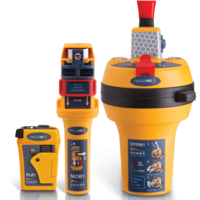1-800-832-7191
EPIRBS AND PLBS

WHAT ARE EPIRBS AND PLBS
First of all EPIRBS and PLBS are acronyms. EPIRB stands for Emergency position indicating radio beacon. PLB stands for personal locator beacon. A PLB is the smaller counterpart of an EPIRB. In any case they are both life-saving devices. By simply turning them on, they send out an SOS signal via satellite. They directly inform search and rescue personnel of your position from virtually anywhere on the planet. EPIRBs and PLBs are saving hundreds of lives every year and operate easily under duress or stress.
WHAT IS THE DIFFERENCE BETWEEN AN EPIRB AND A PLB
The biggest difference between these two devices is that EPIRBs register with the boat. PLBs are for use by an individual. EPIRBs mount on the boat itself. PLBs are usually worn on a PFD. They can also fit nicely in a dry bag or an emergency go-bag. EPIRBs are larger than PLBs. EPIRBs usually have more battery life. In fact they require them to have a minimum of 48 hours of battery life. On the other hand, they require the PLBs have only half that at 24 hours of battery life. EPIRBs always have a strobe light built in, while PLBs may or may not have a strobe light.
HOW DOES AN EPIRB WORK
Firstly, when a locator beacon activates it transmits an SOS message to a rescue dedicated satellite. Secondly, the distress signal relays to a network of ground stations. Thirdly, this triggers alerts to the appropriate local or national authorities to initiate a search and rescue mission. Furthermore authorities will attempt to contact the beacon owner to make sure that it hasn’t been an accidental triggering. Above all rescuers can initiate a response within minutes.
The Category I EPIRB design will automatically release from its mounted position and activate when they become submerged. The Category II EPIRB design allows for both hard mounting or hand carrying. Category II’s also activate manually if need be. Modern EPIRBs and PLBs models generally have internal GPS. Unlike the past this allows them to transmit their exact location when activated within seconds. Most importantly this reduces the search-time massively. As a result, as many say, the modern day EPIRBs and PLBs takes the search out of search and rescue.
By law, you must register a locator beacon with the National Oceanic and Atmospheric Administration (NOAA). There is a link at the bottom of this blog. Once registered the beacon’s unique 15-digit identification code is then associated with either your boat or you personally. Hence when triggered and begins transmitting its signal, the authorities immediately know who and where you are. They will also know all the ancillary information you added at registration.
WHERE CAN I GET THEM
So the truth is that EPIRBs and PLBs are affordable. You can do an internet search and find hundreds of makes and models online. Most any Marine Shop will be able to help you as well.
Keep in mind that although these devices must be registered to a boat or a person, one can rent an EPIRB or PLB. Once again, at a very reasonable price. The beacons you rent are pre-registered and when rented, you’ll provide your vessel type, itinerary, and other pertinent information. Subsequently, if a unit gets triggered, the information immediately passes this information on to the US Coast Guard.
Considering how much these units enhance your safety at sea, most boaters would surely agree that getting a modern EPIRB or PLB is well worth the investment.
IN CONCLUSION
Here is a great page from NOAA’s website further clarifying and linking information regarding registrations: NOAA – Search and Rescue Satellite Aided Tracking – Emergency Beacons
We include this topic in our Boat licensing course and you can view the avilabe Connecticut Boating Certificates LLC courses here: Public Course Schedule all of our Available Public Classes including Online (www.connecticutboatingcertificates.com)
As always be safe, be smart, and there is no room for egos when passengers lives are in YOUR hands!